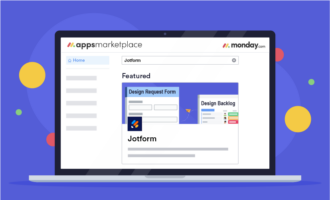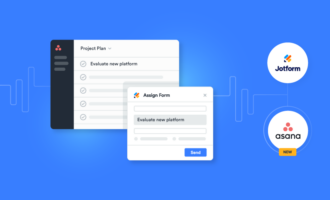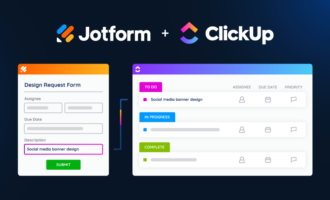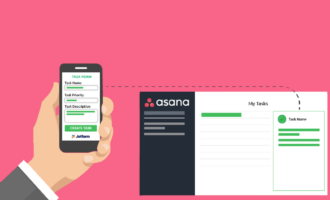Asana and monday.com are both project management tools, but they work differently. Asana is a kanban workflow tool with deep functionality. And monday.com is more of a Swiss Army knife — a versatile set of different tools.
But that doesn’t mean we can’t compare the two. Either one can serve as the primary productivity tool for your team.
In this article, we’ll take a look at both tools, compare their strengths and weaknesses, and see where they overlap and where they differ.
Overview
Both Asana and monday.com are built for project management, but each has their own focus and approach.
Asana
As mentioned above, Asana is basically a kanban tool, similar to Trello, which helps teams visualize the tasks and progress of a project. Each task is represented by a “card,” which moves through different stages of a process until it’s completed.
Asana distinguishes itself by being more focused on teams and facilitating collaboration. With Trello, the kanban board is the whole tool. Asana, on the other hand, is a holistic project management tool that uses kanban boards as its main feature.
monday.com
monday.com is also a project management tool. It also offers the option to use kanban boards to organize your projects, but that’s about where the similarities to Asana end.
monday.com uses workspaces that have boards for different projects or departments. The default boards are similar to Asana, but they offer more functions, such as dashboard and document creation.
You can customize project dashboards with widgets depending on what data you want to see. There are tons of widgets available; they can do everything from summarizing your project’s status to playing YouTube videos.
monday.com is another tool that wasn’t really built for individuals. Its true power lies in the way it helps teams.
Reviews
Both tools are highly rated on G2. They both also have several thousand reviews, so they’re each quite popular.
Asana has more reviews, showing that it’s the most popular of the two — or at least it’s the most well-known.
However, users like monday.com more overall, although only by a little bit. monday.com ranks higher than Asana in almost every category G2 rates, but the difference is usually only by a margin of no more than 2 or 3 percent.
View options
Airtable is another productivity tool that lets you create a single data set and view it as a spreadsheet, a kanban board, a timeline, and more. Since its release, many productivity tools have used that model in their own software. Both Asana and monday.com use Airtable-style views.
Asana is primarily a kanban-style tool, but it lets you view your data as a list, timeline, or calendar as well.
monday.com offers a kanban view, but that’s not the product’s main focus. It also gives you a regular table view, something Asana doesn’t offer.
Pricing
Pricing for monday.com starts at $9 per seat/month with yearly billing, and Asana starts at $10.99 per month with yearly billing.
Both tools offer free plans for individuals, but the paid tiers are meant more for teams. Asana won’t even let you upgrade to a higher tier unless you have multiple users.
That makes sense because you’re really investing in a comprehensive set of tools that facilitates working in teams. You can find every tool that each service brings to the table elsewhere. And usually, the alternatives work better because they’re focused on just that one tool.
For example, monday.com offers a tool for documents called workdocs. It’s similar to Notion, one of the better document tools on the market. Notion is similar to Airtable in that it revolutionized note-taking apps, and now lots of other tools imitate it.
But monday.com’s workdocs tool isn’t as comprehensive and sophisticated as Notion. monday.com really shines because it brings so many tools together and makes them work better for teams. You could say the same thing about Asana.
Integrations
Asana really shines when it comes to integrations. It offers more than 330 integrations, while monday.com offers more than 100.
Choosing the best tool for your team
Of the two tools, monday.com has a steeper learning curve to get started. The user interface is easy enough to use in either app, but monday.com just has many more built-in features and extras to explore.
Because of that, monday.com would likely be better suited to a more tech-focused team. If your project managers want lots of different ways to manage their projects, monday.com may be best. It gives them the ability to really geek out and create a custom experience for each project.
On the other hand, if you want a tool that just works and gets out of your way, Asana may be better. Asana seems to assume that it doesn’t have to be the only tool you use, which is why it has so many integrations.
Both of these tools streamline communication, but neither of them automates it completely. Also, neither of them does a lot to help you communicate outside your team.
To accomplish that, you’d need another tool like Jotform. Jotform is an online form tool that offers many project management features for teams as well.
If you’re looking to round out your suite of tools, Jotform is a valuable addition, and it connects seamlessly with both Asana and monday.com. With these integrations, you can have form submissions from outside your organization automatically populate to your project management platform of choice. Learn more about what Jotform can do for your team here.





























Send Comment: